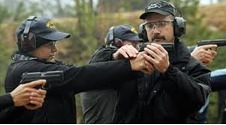Written by Benjamin Kurata
(Continued from last week…)The following are arbitrary levels and goals of shooting performance. I use the word arbitrary as I have chosen them with no other intent than to place a stake in the sand so that the shooter can think about where (s)he is and where (s)he wishes to go with his / her training. What follows can be applied to shooting paper targets on a square, flat range (SFR) up through diminished light force-on-force scenarios.
BEGINNER LEVEL:
Emphasis:
- Basic skill development (consistency in shooting position, grip, sight picture, trigger manipulation, follow through);
- Safe, correct gun handling skills.
Shooter Position:
- Static, i.e.,
- Modified Isosceles
- Weaver
- Chapman
- Etc.
Conditions:
- Bright, well lit.
Target(s):
- Static, known distance from shooter, high contrast (bullseye, PPC, Q, etc).
Time:
- Unlimited or generous.
Acceptable outcome or goal:
- All shots impact upon designated target area (target face, scoring rings, qualification area, etc.). NO MISSES!
INTERMEDIATE LEVEL:

- Introduce / develop dynamic target / environment skills;
- Introduce / develop dynamic decision making skills.
- Safe, correct gun handling skills.
Shooter Position:
- Static (see above) between 75% and 50% of the time (gradually decreasing);
- Dynamic or moving between 25% and 50% of the time (gradually increasing).
Conditions:
- Bright, well lit, 50% of the time;
- Diminished light 25% of the time;
- No light 25% of the time (requires auxiliary lighting source).
Target(s):
- Static, 50%;
- Moving, uniform rate, known distance, 50%;
- Uniform appearance 50%;
- Non-uniform appearance (requiring shoot / no shoot decision) 50%.
Time:
- Set time limits, challenging but achievable.
Acceptable outcome or goal:
- No misses;
- No no-shoot targets hit.
ADVANCED LEVEL:
Emphasis:
- Sound decision making skills (shoot / no shoot);
- Sound use of environment (cover, concealment, light, darkness, movement);
- Safe, correct gun handling skills.
Shooter Position:
- Static 20% of the time (behind cover, prone);
- Dynamic or moving 80% of the time.
Conditions:
- 100% diminished or no light (requires auxiliary lighting source).
Target(s):
- 100% humanoid threat / no threat / varying levels of threat unless skill development is indicated – then bullseye, Q, etc.
- Static but reactive, 50% (fire until threat is gone);
- Moving, non- uniform rate, unknown distance, 50%;
- Non-uniform appearance 100%.
Time:
- Tight, dependent upon scenario. Shoot / no shoot available for short period of time before disappearing.
Acceptable outcome or goal:
- Sound decision making:
- Shoot / no shoot;
- Use of environment / movement;
- No misses on threat targets;
- All shots in vital area or threat down (reactive)
- No no-shoot targets hit.
Now, your first reaction upon reading this may be; “Nobody shoots at the Advanced Level.” Two responses:
1. Yes, there are entire people that shoot at the Advanced Level consistently, both as individuals and as teams. I will not be so arrogant as to claim that I shoot at this level, but I have had the benefit of training with individuals and teams that do.
2. As trainers, if we do not expect / demand better performance of those we train, will they ever improve? Again, as humans, we rise or fall to the level of expectation. So, as trainers, part of our job is to keep introducing more challenging, more realistic, and MORE DIFFICULT problems for the operator(s) to solve.
(Author’s Note: I started this article in 2000, but shelved it because nobody in my organization at that time was interested in discussing proficiency. Recently, a nationally published writer called and asked us about proficiency levels and evaluation, so it might be a good time to visit this subject again.)
*Note: Action Target has recently been offering firearm training manuals for sale at our online store. We only charge the cost to produce and ship the item. There are no hidden fees. We believe that your safety is that important, so we elect not to capitalize on the manuals. To get your own hard copies of these training manuals, please click here.






